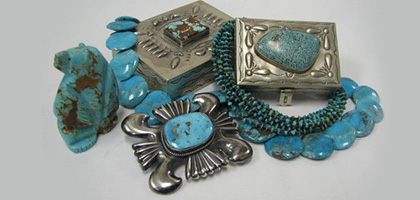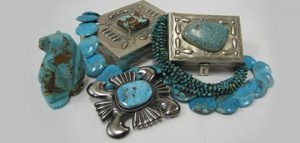 At Palms, we feel it is our privilege and our obligation to stay informed and educated regarding the various facets of our business and the products we sell. We also know it is important to pass this knowledge on to you, our valued customers. As turquoise has gained popularity throughout the years, particularly in the fashion world, we would like to take this opportunity to provide some insight into the value of turquoise so that, if you would like to incorporate this stone into your wardrobe, you are able to make the best possible decisions. The following information has been paraphrased from the publication Turquoise Annual: Volume I from the year 1976.
At Palms, we feel it is our privilege and our obligation to stay informed and educated regarding the various facets of our business and the products we sell. We also know it is important to pass this knowledge on to you, our valued customers. As turquoise has gained popularity throughout the years, particularly in the fashion world, we would like to take this opportunity to provide some insight into the value of turquoise so that, if you would like to incorporate this stone into your wardrobe, you are able to make the best possible decisions. The following information has been paraphrased from the publication Turquoise Annual: Volume I from the year 1976.
Turquoise value is dependent upon four facets: density, matrix, color and size. While density is often used 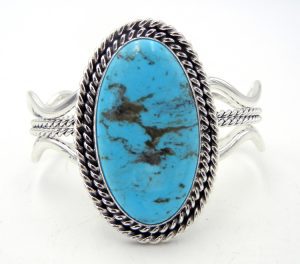 interchangeably with hardness, they are, in fact, different. Hardness involves the ability of a stone to resist abrasion, while density is defined as “the quantity per unit volume or mass of the stone.” While both are important factors to be considered, density is more critical, for two reasons. First, density will take and hold a high polish and second, few corrosives penetrate and affect a dense stone.
interchangeably with hardness, they are, in fact, different. Hardness involves the ability of a stone to resist abrasion, while density is defined as “the quantity per unit volume or mass of the stone.” While both are important factors to be considered, density is more critical, for two reasons. First, density will take and hold a high polish and second, few corrosives penetrate and affect a dense stone.
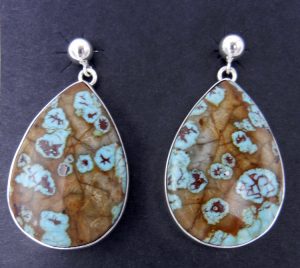 Matrix, the second determinant, is one of the main components in attributing value to turquoise. In fact, matrix influences value in three ways: by its density, binding, and pattern. Density of the matrix is similar to density of the actual stone; higher quality with accept a polish and will not undercut , or wear away under abrasion, when the stone is being shaped, thereby enhancing the surrounding turquoise. The second attribute, binding, relates to “how well the matrix is bonded to the turquoise.” A well-bonded matrix can be one of the finest characteristics of a turquoise stone; not only is the border between the two rock types smooth and clean, the stone is less apt to crack along the matrix lines. Finally, pattern relates to how the matrix is dispersed throughout the stone and determines a stone’s attractiveness. Thin, well balanced groupings of matrix are highly coveted, thus the reason spiderweb patterns command high prices.
Matrix, the second determinant, is one of the main components in attributing value to turquoise. In fact, matrix influences value in three ways: by its density, binding, and pattern. Density of the matrix is similar to density of the actual stone; higher quality with accept a polish and will not undercut , or wear away under abrasion, when the stone is being shaped, thereby enhancing the surrounding turquoise. The second attribute, binding, relates to “how well the matrix is bonded to the turquoise.” A well-bonded matrix can be one of the finest characteristics of a turquoise stone; not only is the border between the two rock types smooth and clean, the stone is less apt to crack along the matrix lines. Finally, pattern relates to how the matrix is dispersed throughout the stone and determines a stone’s attractiveness. Thin, well balanced groupings of matrix are highly coveted, thus the reason spiderweb patterns command high prices.
Color as a factor in the value of turquoise is the most subjective of the four. While many opinions regard robin’s-egg blue as the color in turquoise, others suggest that color is in the eye of the beholder. Ultimately, color is a personal 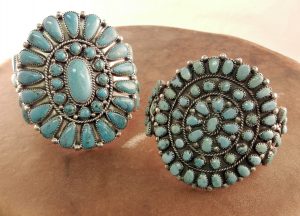 preference, however; a survey conducted during the time of the publication of this text indicated that men prefer blue, while women lean toward green hues.
preference, however; a survey conducted during the time of the publication of this text indicated that men prefer blue, while women lean toward green hues.
Lastly, size-the final criterion-is self-explanatory: the larger the size of the stone, the greater the value per unit of weight. A 40 carat stone will garner a much higher value (often more than twice) than a 20 carat stone of similar quality. A carat, in turn, is the unit of measurement used to describe the weight of stones. One carat is equal to .2 grams or .007 ounces.
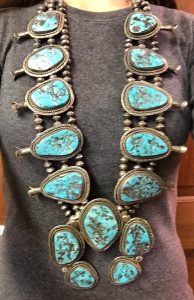 Native American women learned the inherent value of turquoise immediately. It is a well known fact that Navajo women, especially many years ago, would use their jewelry as a personal bank account. The vast majority of these women would use their nicest pieces to pawn, offering the jewelry as collateral until they could re-claim the pieces at a later date.
Native American women learned the inherent value of turquoise immediately. It is a well known fact that Navajo women, especially many years ago, would use their jewelry as a personal bank account. The vast majority of these women would use their nicest pieces to pawn, offering the jewelry as collateral until they could re-claim the pieces at a later date.
Today, the best way to ensure yourself a quality piece of turquoise is to know your dealer well and trust his or her judgment. The Palms staff strives every day to offer you valuable pieces at affordable prices, keeping the aforementioned characteristics in mind.



